India, or Bharat as it is traditionally known, has a rich and profound history of education and knowledge spanning thousands of years. From ancient universities spread across the land to pioneering contributions in various fields of science and mathematics, Bharat has long been a cradle of knowledge. Yet, paradoxically, in the last two millennia, there appears to be a conspicuous absence of significant scientific and technological inventions emerging from this ancient civilization. What led to this decline? And more importantly, how can we reclaim and understand the true legacy of Bharatiya Ganita Shastra—Indian mathematics? This article explores these questions by delving into the mindset required to appreciate the depth and breadth of India’s mathematical heritage, while also addressing the socio-political and cultural factors that influenced the evolution of education in Bharat.
This comprehensive exploration is inspired by the insightful perspectives of Project Shivoham, who has launched a dedicated series called Bharatiya Ganitam to illuminate the vast contributions of India in mathematics over millennia. Let us embark on this journey to uncover the truth, dispel myths, and nurture a critical, inquisitive mindset toward our ancient knowledge systems.
Table of Contents
- Ancient Bharat: A Land of Universities and Knowledge
- The Puzzling Decline: Why Did Bharat Lose Its Scientific Edge?
- Bharatiya Ganita Shastra: What Is It and Why Does Mindset Matter?
- The Mindset Challenge: Why Understanding Bharatiya Ganita Requires Open Minds
- Dispelling Myths: Zero and Other Contributions
- The Importance of Mindset: Critical Thinking and Inquisitive Learning
- Science and Dharma: Harmonious in Bharat’s Tradition
- Conclusion: Embracing Bharatiya Ganitam with an Open Mind
- Frequently Asked Questions (FAQ)
Ancient Bharat: A Land of Universities and Knowledge
Just take a moment to look at the map of ancient Bharat. Across this vast land, there existed numerous universities and educational hubs that thrived for thousands of years. These centers were not mere places of rote learning but vibrant institutions nurturing diverse fields of education and research.
As the sloka from the Vishnu Purana beautifully states:
“The country that lies north of the ocean and south of the Himalayas is called as Bharatam. The people living in this part of the land are the children of Bharati.”
The literal meaning of the word Bharati is “the one who carries knowledge.” This etymology reflects the intrinsic value placed on knowledge and learning in the cultural fabric of Bharat.
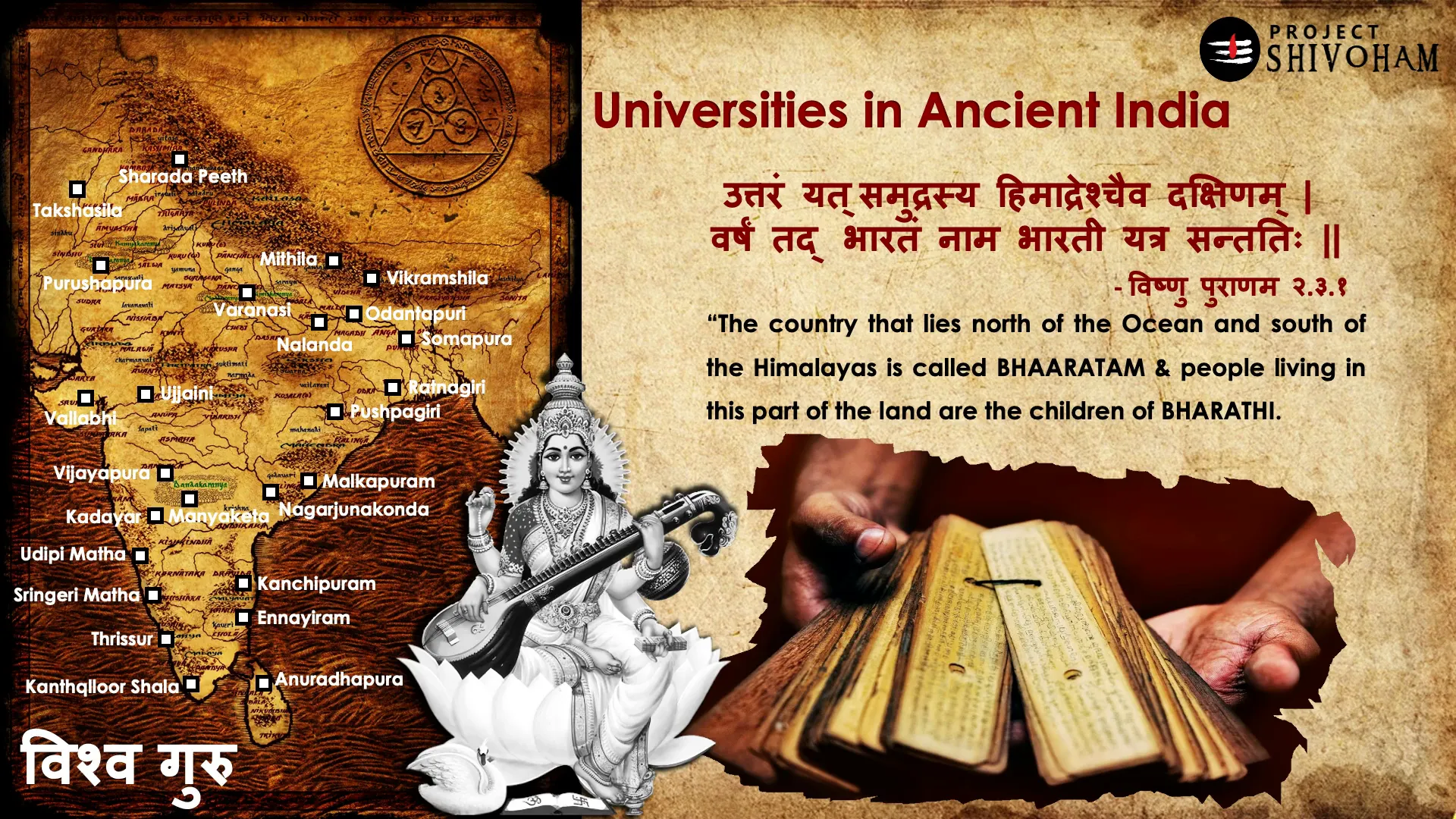
The Puzzling Decline: Why Did Bharat Lose Its Scientific Edge?
If Bharat was once a beacon of education and innovation, why has there been such a dearth of significant inventions from this land in the last two thousand years? This is a fundamental and genuine question that deserves an unbiased and holistic examination.
Four main reasons have been identified as contributing to the decline of the grand education system of ancient Bharat:
- Pseudo Brahminical hostility in education
- Islamic invasions and destruction of universities
- Imposition of English education system by the British
- Pseudo secularism and political agendas preventing revival
While the second and third reasons relate to external invasions and colonial impositions, this discussion will focus primarily on the first and fourth reasons, which highlight internal social dynamics and contemporary responsibilities.
Pseudo Brahminical Hostility in Education: Understanding the Root Cause
Before we delve into the concept of pseudo Brahminical hostility, it is vital to understand what a Brahmin truly is. Contrary to popular misconceptions tied to birth and caste certificates, the ancient Indian scriptures define Brahmins based on qualities and knowledge, not birth.
From the Vasistha Dhanurveda Samhita, an ancient scripture on warfare and weapons authored by Vasistha Maharshi, the guru of Bhagwan Shri Ram, we find illuminating definitions:
“Dhanurvedam should be taught only to a Brahman. And who is a Brahman? That person who is not a miser, who is not crooked in attitude, who is not dull-headed, and who has a sense of gratitude.”
In essence, a Brahmana is defined by noble qualities such as generosity, clarity of mind, and gratitude. This classification is based on personal virtues rather than hereditary status.
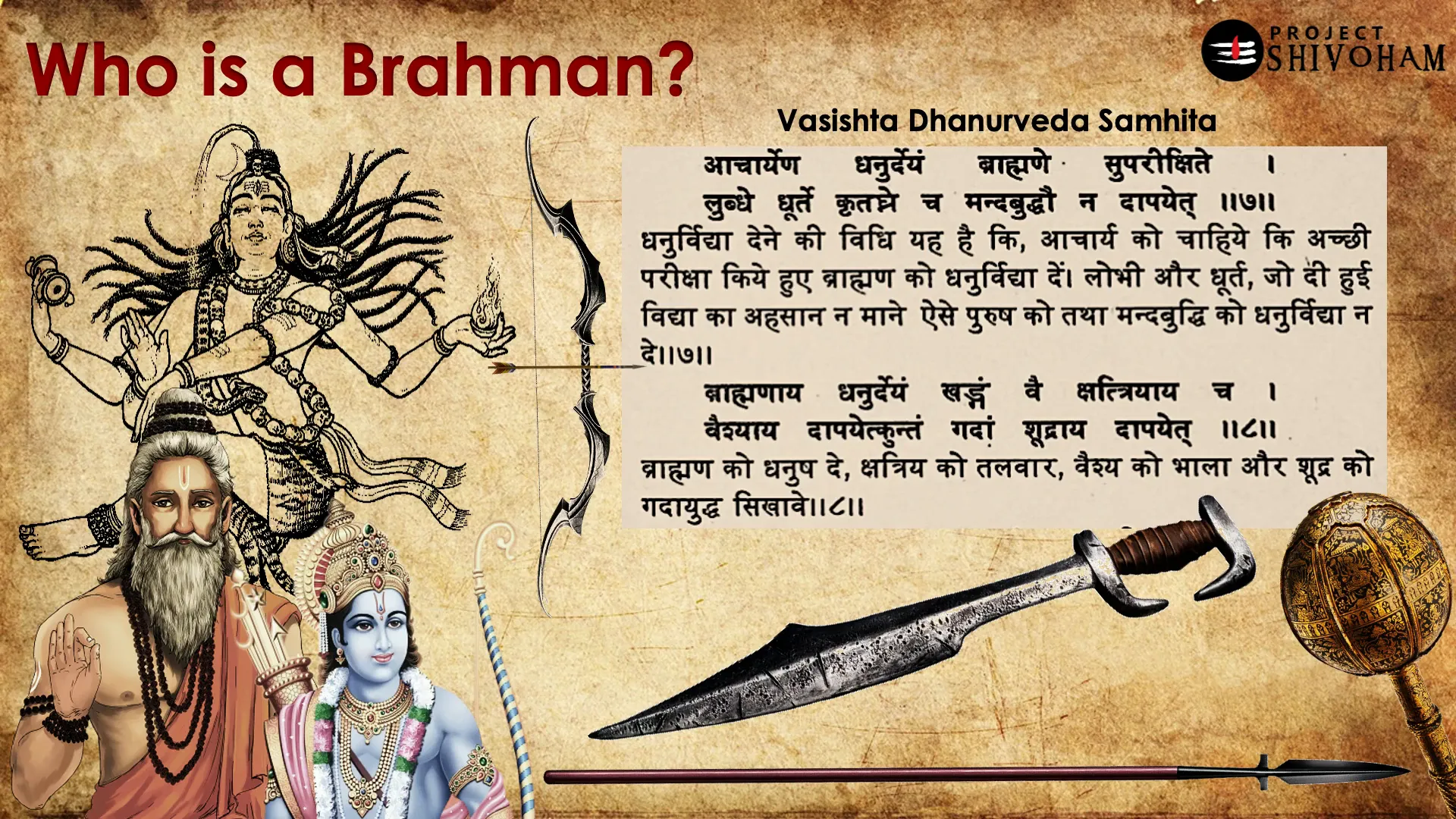
What about the rest of society? Does this mean only Brahmins could learn or fight? Vasistha Maharishi clarifies further:
- A Brahmana should learn archery (bow and arrow).
- A Kshatriya should learn sword fighting.
- A Vaishya should learn to fight with spear.
- A Sudra should learn to fight with mace.
This division of roles, known as Chaturvarna, is based on the qualities and psychological strengths of individuals, not birth. The person with the highest psychological strength is entrusted with the most skillful weapon—bow and arrow—while others are entrusted with weapons suited to their disposition.
This system emphasizes meritocracy and aptitude rather than rigid caste hierarchies.
To further emphasize, Bhagavan Sri Krishna in the Bhagavad Gita states:
“The four categories of people were created by Me according to people’s qualities and activities.”
Thus, the ancient Indian education system was inclusive, focusing on qualities, devotion, and dedication rather than birth or caste certificates. Unfortunately, over time, this noble definition of Brahmana was distorted in certain regions, creating a hostile environment that alienated large sections of society from education.
This pseudo Brahminical hostility contributed significantly to the downfall of the ancient Indian education system, creating barriers where there should have been bridges.
The Present-Day Responsibility: Pseudo Secularism and Political Agendas
The fourth reason for the decline is the present-day mindset—pseudo secularism and political agendas that have failed to revive the destroyed education system. This is a critical issue because it involves the collective responsibility of society today.
In the name of secularism or minority appeasement, the rich educational heritage of Bharat, which is tightly coupled with Sanatana Dharma (the eternal way), is often brushed under the carpet. The fear of offending religious sentiments or political correctness leads to the suppression of this knowledge rather than its celebration.
But secularism should mean equal respect for all religions under the law, not the erasure or sidelining of the indigenous knowledge systems that are deeply intertwined with the culture and spirituality of Bharat.
Bharatiya Ganita Shastra: What Is It and Why Does Mindset Matter?
Now, shifting our focus to the heart of this discussion—Ganita Shastra, or Indian mathematics. What exactly is Ganita?
Let’s explore the etymology first. Consider the word Ganapati, a revered deity in Bharat. It is composed of two words: Gana (meaning group, count, or multitude) and Pati (meaning leader). Ganapati thus means the leader of the groups, specifically the leader of the Shivaganas.
Drawing from this, Ganita means counting or mathematics—the science of numbers and groups.
It is important to note that in Hindi, other related words like Ganatantra (republic) or Janaganana (census) also use Gana. But Ganita specifically refers to the field of study dealing with counting and numbers.
The reason for highlighting the term Ganapati is to underscore a critical issue: in Bharat, education, including mathematics, has historically been deeply integrated with spiritual and philosophical aspects of life. This holistic approach is often misunderstood or dismissed today.
Because of political sensitivities and misplaced notions of secularism, this spiritual-philosophical connection is often ignored or deliberately hidden. This results in a gross underestimation of the depth of Indian mathematics and its origins.
Jyotisha Shastra: The Root of Ganita Shastra
The foundations of Ganita Shastra lie in Jyotisha Shastra, a branch of Vedic knowledge concerned with astronomy and astrology. Unfortunately, many people today associate Jyotisha merely with pseudoscience or superstition, which is a grave misunderstanding.
In reality, Jyotisha Shastra is a precise science of timekeeping, planetary movements, and celestial calculations. It has been an integral part of the Vedic education system for thousands of years.
The planetary positions—the Navagrahas (nine celestial bodies including five planets, the Sun, Moon, and two lunar nodes)—have been worshipped and studied meticulously in Bharat. Calculating their positions accurately was crucial for various activities, whether religious, agricultural, or social.
How were these calculations done? By observing the position of planets against the backdrop of constellations as visible from Earth. This required advanced mathematical tools and methods, including trigonometry, geometry, and calculus.
Thus, Jyotisha Shastra is fundamentally about precise computation of time and planetary positions, and it gave birth to several advanced mathematical disciplines.
Origins of the Hindu Number System in the Vedas
Digging deeper into the roots of Indian mathematics, one finds the earliest references to the place value system in the Yajurveda. In the Shukla Yajurveda, as part of ceremonies worshipping Agni Deva (fire god), there are verses quoting powers of ten:
- One
- Ten
- Hundred
- Thousand
- Ten thousand
- Hundred thousand
- Million
- Hundred million
This shows that ancient Indians were familiar with very large numbers, both in theory and practice.
Building on this foundation, Aryabhata, the great Indian mathematician and astronomer, conceptualized and perfected the base ten place value system that the world uses today. Contrary to popular belief, Aryabhata did not invent zero itself but refined the positional system that made calculations efficient and scalable.
In his work Aryabhatiya, Aryabhata writes:
“Ekam dasha cha satam cha sahasram… Sthanam dasha gunam syat.”
Meaning, the value of a number depends on its position (Sthanam) and is multiplied by powers of ten (Dasha gunam syat).
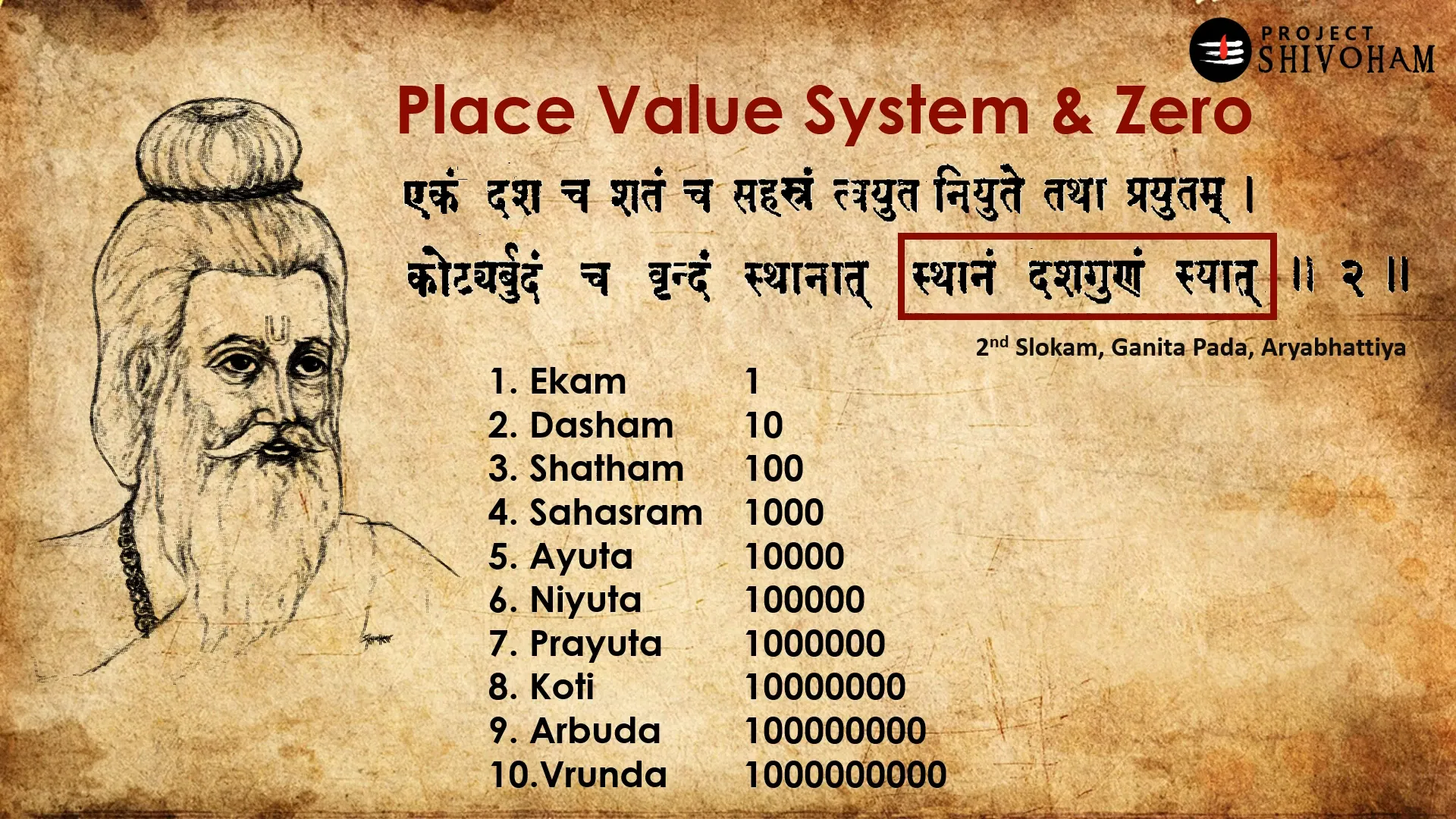
The Mindset Challenge: Why Understanding Bharatiya Ganita Requires Open Minds
The core challenge in appreciating Bharatiya Ganita is not just historical or academic but psychological and cultural. Many people today react to the idea of teaching the Hindu number system’s origins from the Vedas with accusations of violating secularism or political agendas. This is a tragic misunderstanding.
Mathematics and education in Bharat have always been inseparable from spiritual and philosophical contexts. To ignore or reject this connection is to deny the essence of the knowledge tradition.
Secularism should mean equal respect for all, not the suppression of indigenous knowledge for fear of offending others. The rich intellectual heritage of Bharat deserves to be taught fully and factually, free from narratives, propaganda, or political interference.
How the Hindu Number System Spread to the World
The base ten positional number system, also known as the Hindu number system, traveled westward from Bharat through a fascinating historical journey:
- 7th Century: Severus Sebok, a Christian monk from Syria, introduced the number system to Syria and by extension West Asia.
- 8th Century: Al-Khwarizmi brought it to Persia, where it became further developed.
- 12th Century: Leonardo Pisano, known as Fibonacci, introduced it to Italy and Europe through his book Liber Abaci.
This number system challenged the prevalent Roman numeral and abacus-based calculations in Europe and revolutionized arithmetic operations globally.
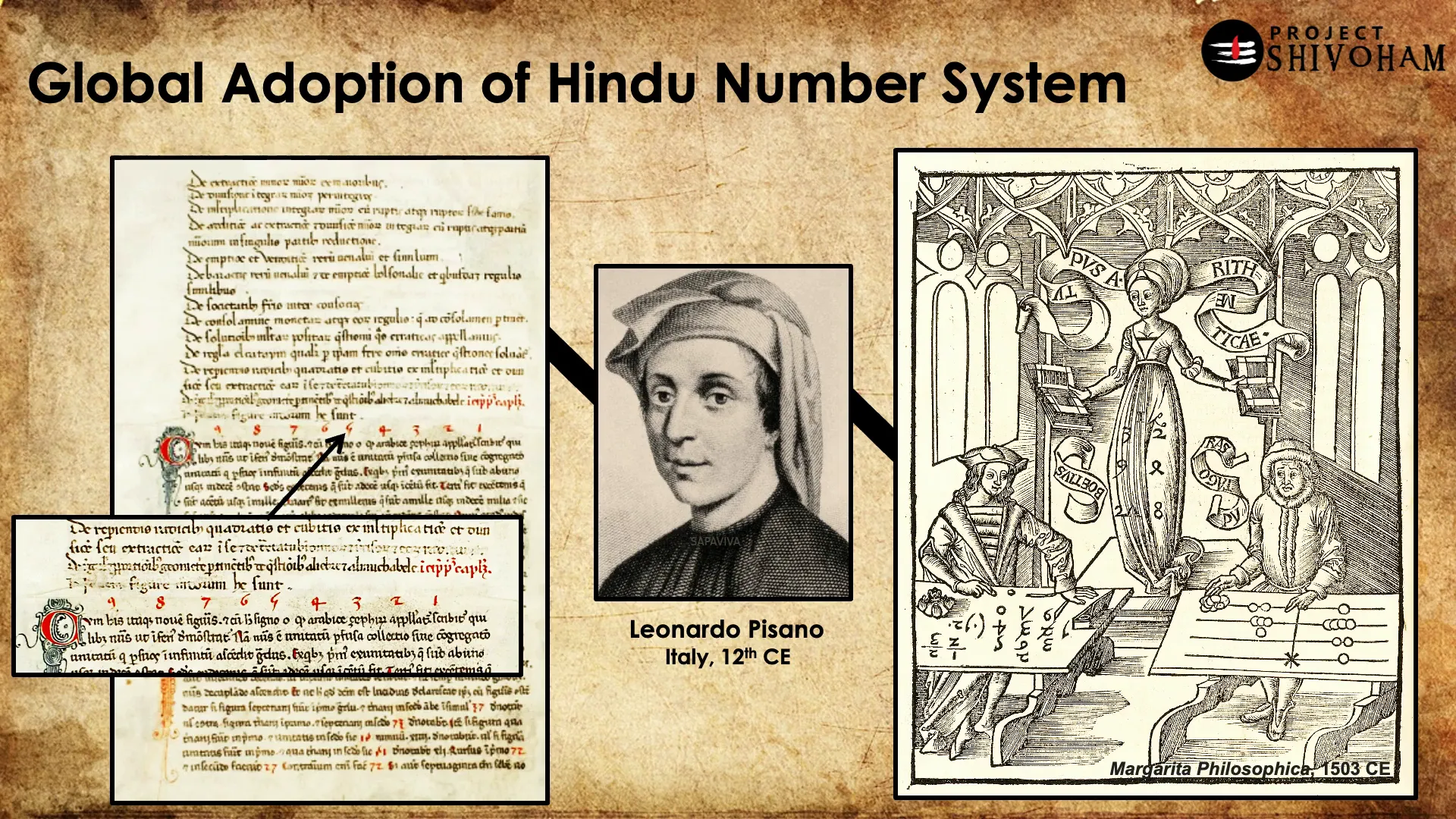
Interestingly, Fibonacci himself acknowledged learning this system from the Indians, highlighting the deep influence of Bharatiya Ganita on global mathematics.
Dispelling Myths: Zero and Other Contributions
When asked about Indian contributions to mathematics, most people give the simplistic answer that India invented zero. This is fundamentally incorrect and a gross oversimplification.
Zero as a concept was known to many ancient civilizations. The real Indian contribution lies in perfecting the positional place value system, which allowed for efficient computation and the widespread adoption of the number system globally.
Teaching the full history of the Hindu number system means starting from the Vedas and tracing its journey across the world. Unfortunately, any such effort is often met with resistance citing freedom of religion or secularism.
But history must be taught as it is—based on facts, not narratives or propaganda.
Introducing Bharatiya Ganitam: A Web Series to Reclaim Indian Mathematical Heritage
To address this gap in awareness and to counter misinformation, Project Shivoham has launched Bharatiya Ganitam, a web series dedicated to unveiling every speck of research and innovation in Indian mathematics over thousands of years.
This series will cover the contributions of legendary mathematicians such as:
- Boudhayana
- Manava
- Apasthamba
- Panini
- Katyaayana
- Varahamihira
- Brahmagupta
- Bhaskara
- Mahavira
And many more, highlighting discoveries in applied geometry, calculus, trigonometry, negative numbers, value of pi, algebra, and indeterminate equations.
The goal is to present concise, accessible videos that encourage viewers to research and understand the rich mathematical legacy of Bharat.
The Importance of Mindset: Critical Thinking and Inquisitive Learning
The most crucial obstacle to appreciating Bharatiya Ganita is the mindset. We must cultivate an attitude of open inquiry, free of blind belief or knee-jerk rejection.
As Albert Einstein famously said:
“I have no special talent. I am only passionately curious.”
Similarly, Maharishi Kanadha, who lived around 200 BC to 500 BC and conceptualized gravity long before Newton, emphasized the importance of prayoga (experiments and experience) to gain true knowledge:
“Drushtaanam Drushta prayojanaanam Drushta bhavae prayoga bhudhayaye.”
The path to prosperity is led by observable and experiential experiments, not mere speculation.
By embracing critical thinking and inquisitive learning, we can uncover the real knowledge embedded in Bharatiya Ganita and beyond.
Rejecting Extremes: Neither Blind Nationalism Nor Denial
When discussing Bharat’s contributions, some may blindly claim it was the only country to thrive in ancient science and technology—this is incorrect. Every civilization has its unique contributions.
On the other hand, some dismiss Bharatiya Ganita as ultra-nationalist or far-right propaganda, which is equally wrong and ignores facts.
Neither extreme serves the truth. We must be balanced, open-minded, and willing to learn and appreciate knowledge from all cultures.
Science and Dharma: Harmonious in Bharat’s Tradition
One of the fascinating aspects of ancient Bharat is the harmony between science and religion (dharma). Unlike in Europe, where science and religion often clashed, in Bharat, they coexisted without conflict.
This balance is rooted in the education system, where scientific inquiry was deeply connected to spiritual and philosophical understanding.
For a detailed, unbiased account of this unique relationship, one may explore dedicated documentaries and research that shed light on this synthesis.
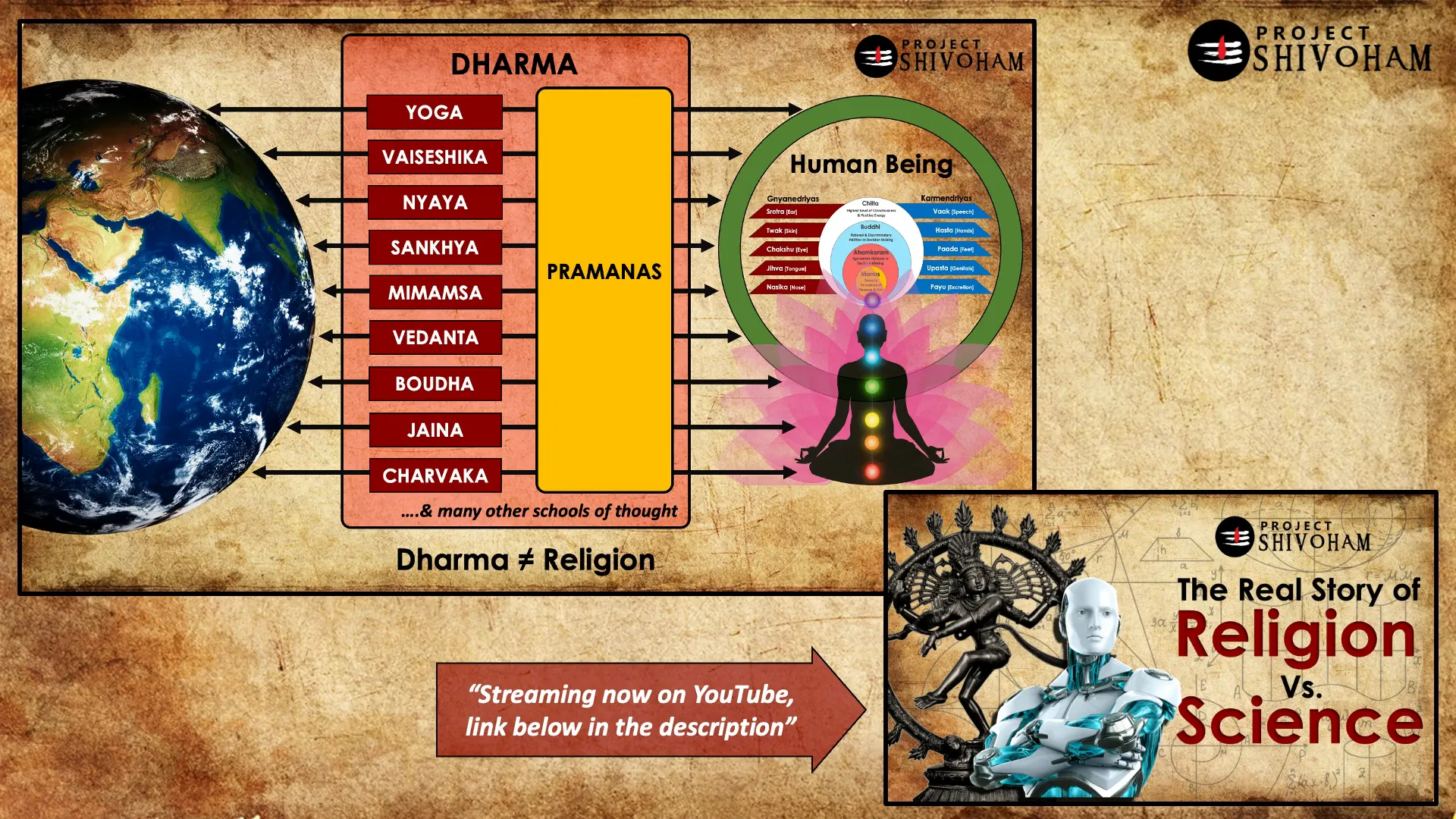
Conclusion: Embracing Bharatiya Ganitam with an Open Mind
This exploration into the mindset behind Bharatiya Ganita Shastra reveals much more than mathematical history—it offers a paradigm for how knowledge should be approached: with respect for facts, openness to inquiry, and freedom from narrow narratives.
The decline of Bharat’s ancient educational system was influenced by both external invasions and internal distortions, but the revival depends on us, on our willingness to learn and teach the truth.
By understanding the true nature of Brahminhood, the origins of mathematical concepts, and the integration of science with spiritual philosophy, we can reclaim the pride and knowledge that Bharat rightfully deserves.
Let us cultivate a mindset of critical thinking, curiosity, and respect for all contributions. The journey has just begun with Bharatiya Ganitam, and there is much to learn, explore, and celebrate.
Frequently Asked Questions (FAQ)
1. What is Bharatiya Ganita Shastra?
Bharatiya Ganita Shastra refers to the ancient Indian system of mathematics that encompasses concepts of counting, arithmetic, geometry, trigonometry, calculus, and more. It is deeply rooted in the Vedic education system and is closely linked with spiritual and philosophical traditions of Bharat.
2. Did India invent zero?
Contrary to popular belief, zero as a concept was known to many ancient civilizations. India’s significant contribution lies in perfecting the base ten positional value system that made arithmetic calculations efficient and universal.
3. What is the relationship between Jyotisha Shastra and mathematics?
Jyotisha Shastra, the science of astronomy and celestial calculations, is the root of many mathematical disciplines in Bharat. It involves precise computation of planetary positions and time, requiring advanced knowledge in trigonometry, geometry, and calculus.
4. Why is the ancient Indian education system often misunderstood today?
The ancient Indian education system was tightly coupled with spiritual and philosophical aspects of life. Modern secularism and political agendas sometimes suppress this connection, leading to misunderstandings and underappreciation of the system’s depth and inclusivity.
5. Who were some notable mathematicians from ancient Bharat?
Notable Indian mathematicians include Aryabhata, Brahmagupta, Bhaskara, Varahamihira, Panini, Mahavira, and many others who made pioneering contributions in various fields of mathematics.
6. How did the Hindu number system reach the West?
The Hindu number system traveled from Bharat to Syria via Severus Sebok, then to Persia through Al-Khwarizmi, and finally to Europe through Leonardo Pisano (Fibonacci), who introduced it in his work Liber Abaci.
7. What mindset is needed to truly appreciate Bharatiya Ganita?
An open, inquisitive mindset that values critical thinking and experiential learning is essential. One should avoid blind belief or rejection and be willing to explore facts without political or religious bias.
8. How can I learn more about Bharatiya Ganita?
Following dedicated series like Bharatiya Ganitam by Project Shivoham, reading ancient texts, and engaging in critical research will deepen your understanding of Indian mathematics and its history.
As we journey through this rich heritage, remember the wise words of Maharishi Kanadha: the path to knowledge is through experiments and direct experience. Let us embrace this spirit and rediscover the brilliance of Bharatiya Ganita.
This article was created from the video Bharatiya Ganitam – Episode 1 – THE MINDSET || Project SHIVOHAM with the help of AI. Thanks to Aravind Markandeya, Project Shivoham.